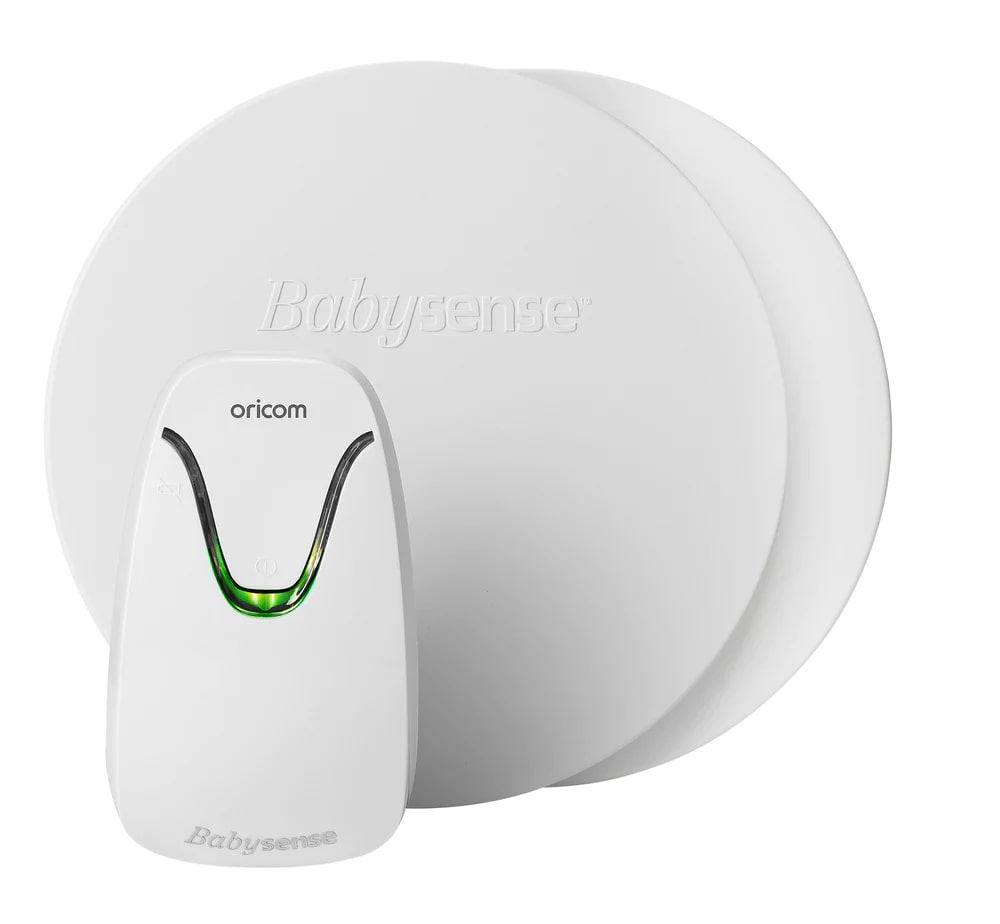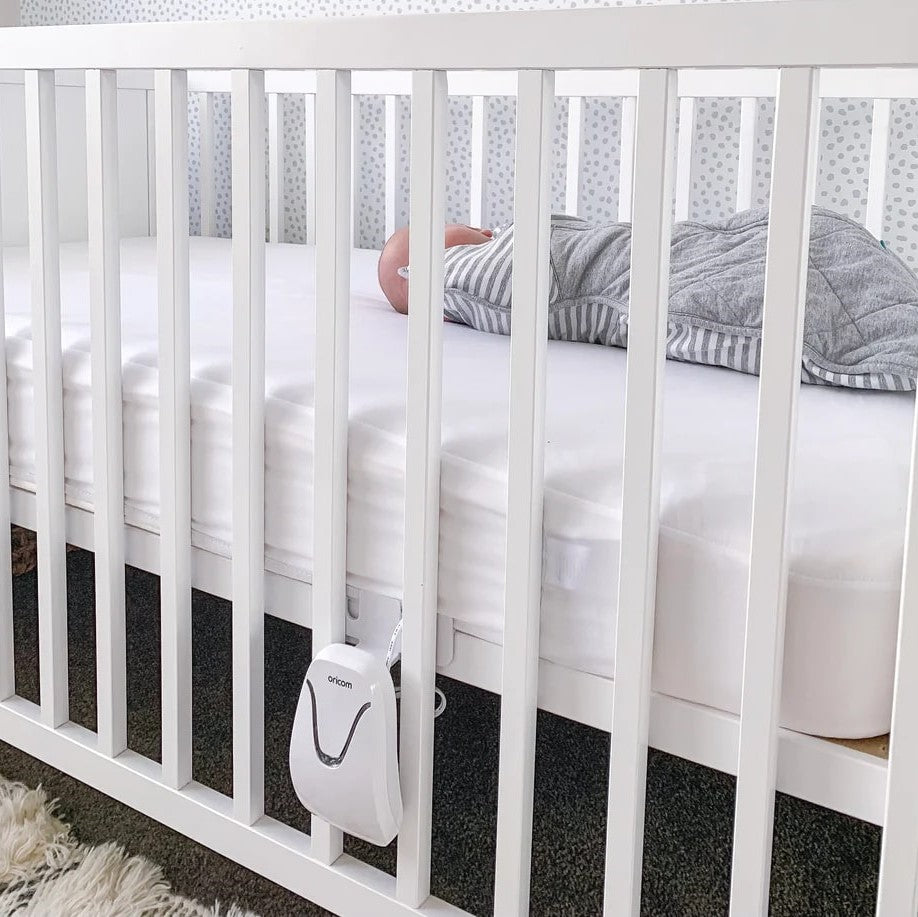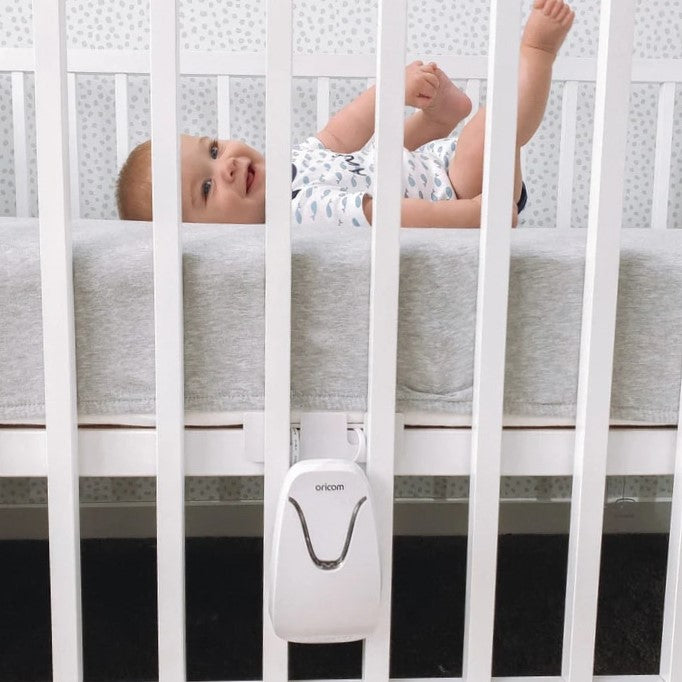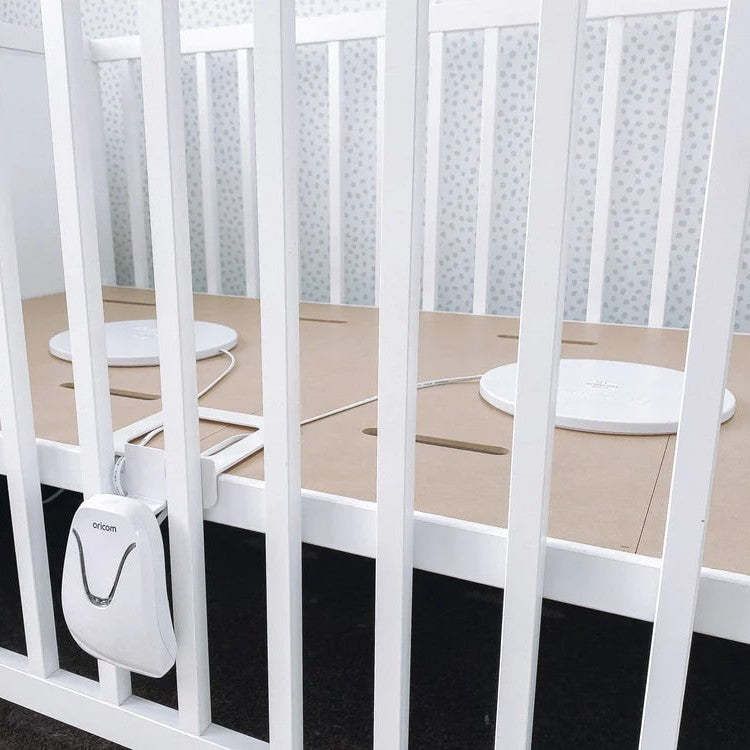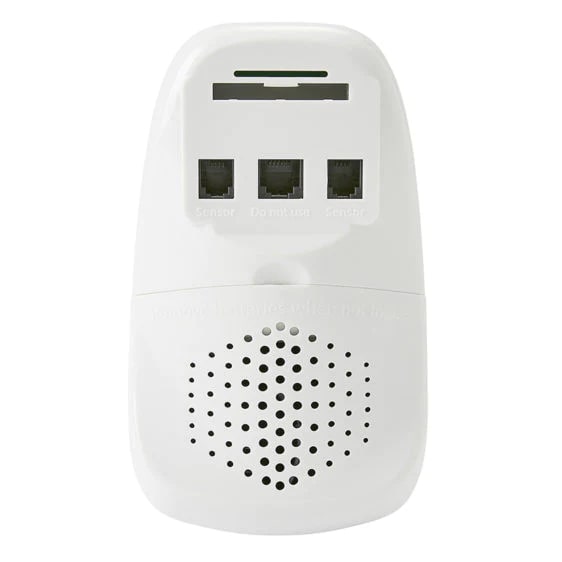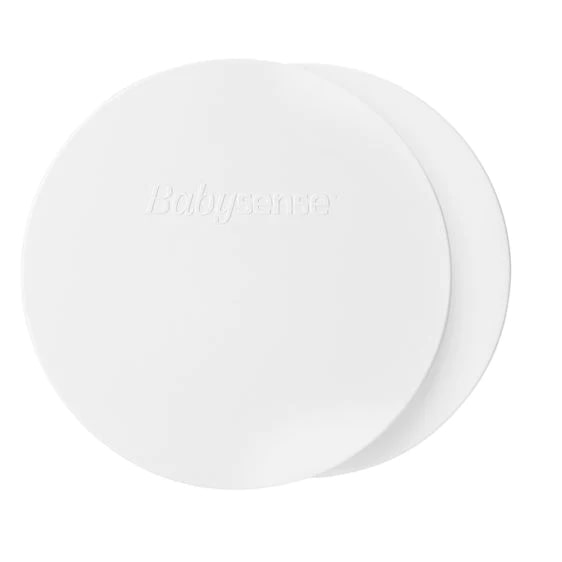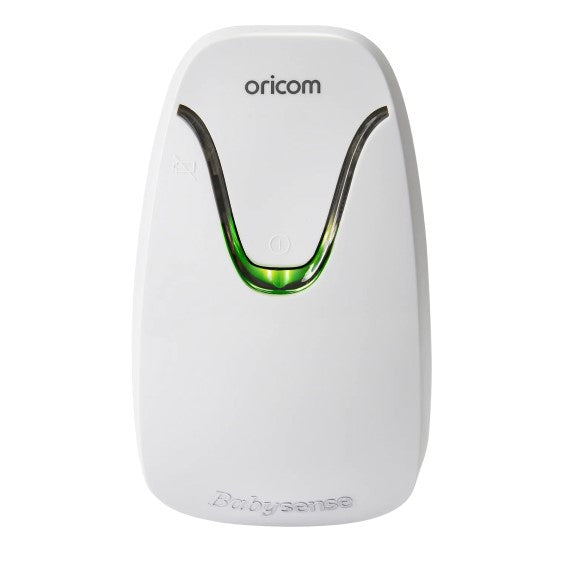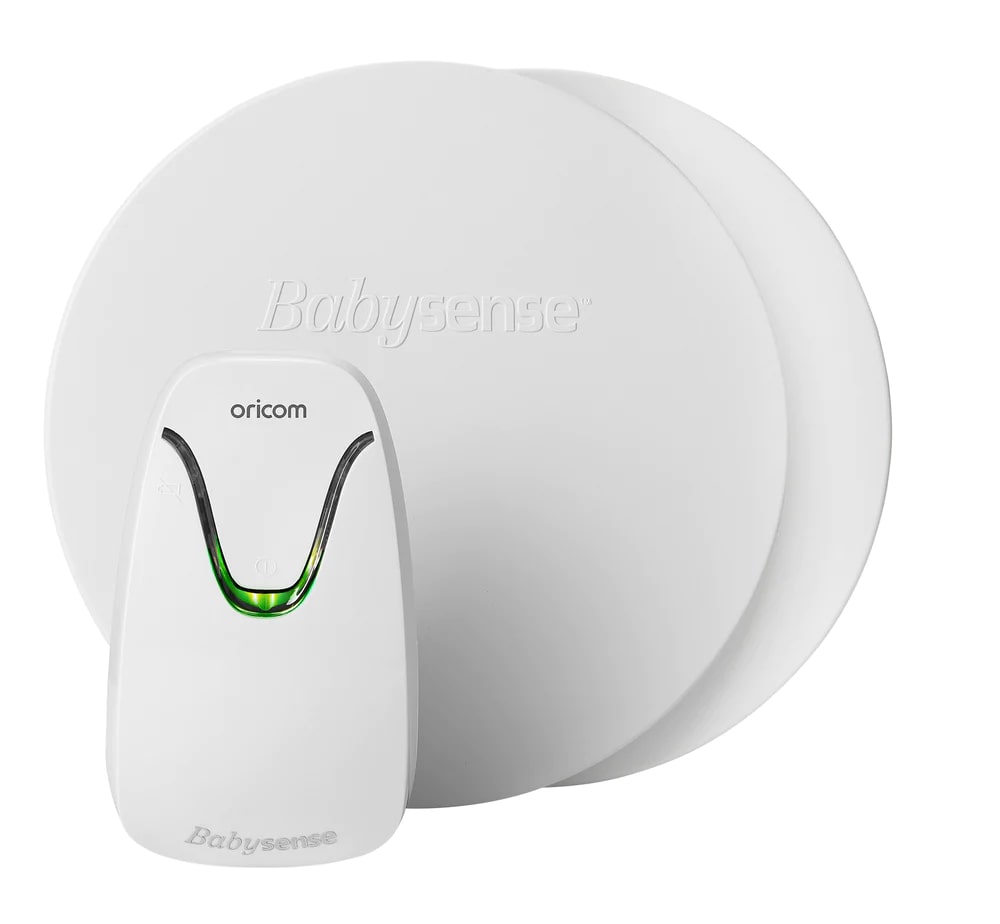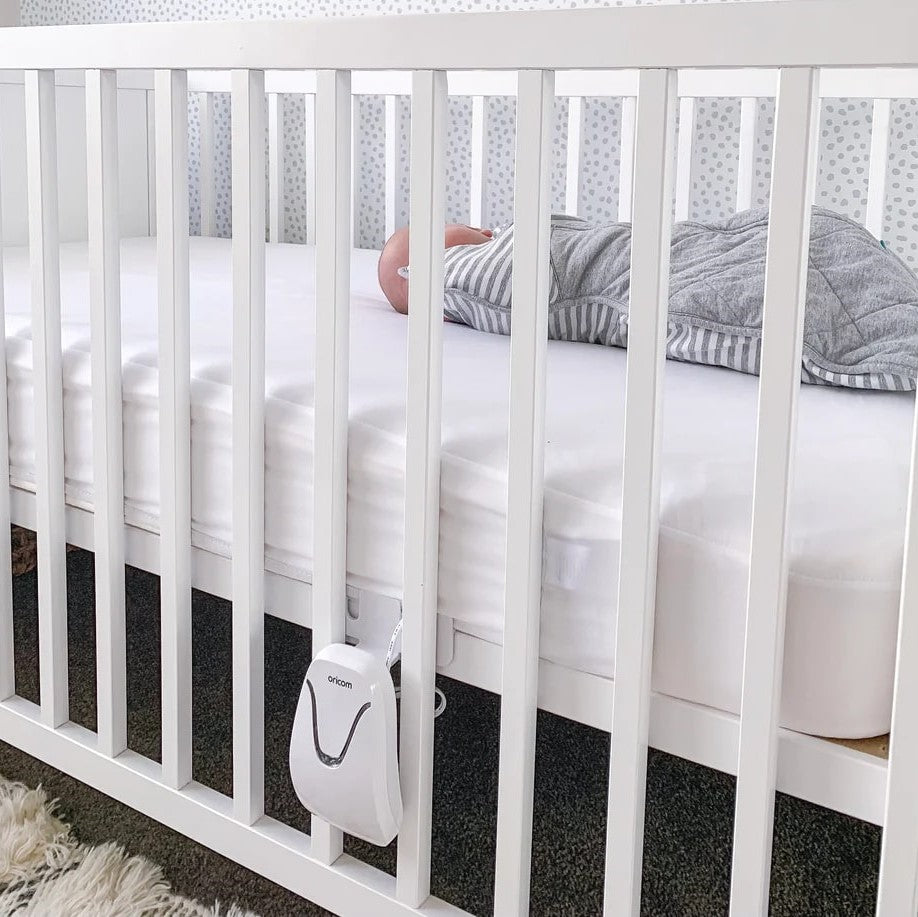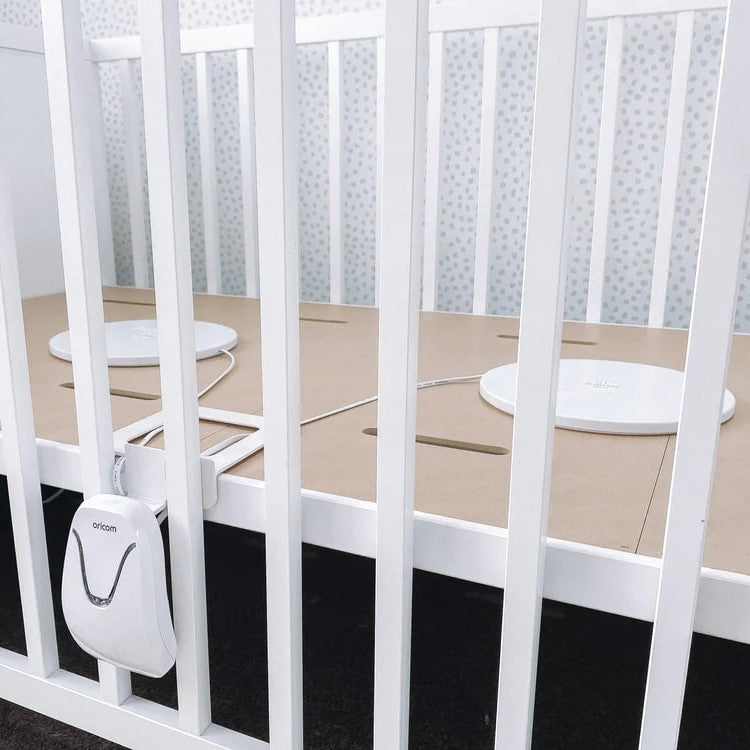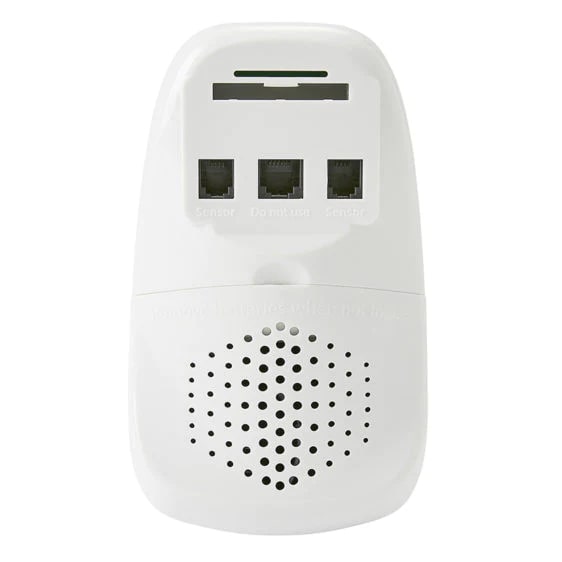Babysense 7 Breathing Movement Monitor
Babysense 7 Breathing Movement Monitor
SKU:SCBS7
In stock
Couldn't load pickup availability
Overview
Overview
Introducing the Babysense7 Breathing Movement Monitor, the latest versio of Oricoms infant breathing movement monitor.
Inside of a modern and streamlined design, the Babysense7 includes the very same technology as the previous model, that New Zealanders have trusted for true peace of mind.
Babysense7 is an integrated system, with a control unit connecting to sensor pads which are placed under your baby’s mattress. The device is designed to continually monitor the breathing movements of your sleeping baby, and if your baby’s breathing movement slows to a rate of less than 10 breaths per minute, or cannot be detected for more than 20 seconds, an audible alarm is activated.
Babysense7 is unique to the market, in that it is included as a medical device on the Australian Register of Therapeutic Goods (ARTG No. 97479), and is battery operated, meaning no power source in and around the cot. The monitoring system continues to give families comfort, by advancing the path to intervention in the event of irregular breathing movement or distress, before it becomes critical. Babysense7 is an additional aid to the normal precautions taken by families in the care of their infant.
Redesigned compact styling with the same proven technology and performance as the original Babysense2.
Babysense7 is included as a medical device on the Australian Register of Therapeutic Goods (ARTG No. 97479)
Continually monitors the breathing movement rate of your baby
An audible alarm is activated if your baby’s breathing movement slows to a rate of less than 10 breaths per minute or cannot be detected for more than 20 seconds
The control unit connects to sensor pads placed under your baby’s mattress
Battery operated
Babysense7 is designed for use on healthy infants up to 12 months of age.
Sensor pads are 1cm thick
Delivery and Returns
Delivery and Returns
- Delivery: Free within NZ on orders over $100 (excluding bulky items) or $8 standard shipping
- Returns: Accepted within 14 days of receipt with proof of purchase
- Some items are excluded from returns including sale items, hardware, car seats, prams, monitors and personal items - please click here for the full list.
Share this product
Recently Viewed Products
Related Blogs
What you need to know about baby monitors
Keep your eye on bubs while they're fast asleep Becoming a parent is a rollercoaster of emotions and new experiences. You’ve spent nine months with your baby tucked safely in your belly, and now that they've made it Earth-side, you can’t wait to bring them home. When it comes to sleeping, you may have your mini-me in your room or nursery. At some point they will move into their own bedroom, and it’s quite natural to feel anxious about leaving your tiny human alone. That’s where baby monitors allow you to keep an eye and ear on your little one from anywhere in the house (outside too!). Baby monitors provide peace of mind for parents who worry that they might not wake when baby stirs or cries, signaling it’s time for a feed – or perhaps just stretching. In today’s tech-driven world, baby monitors are almost a given, and these days they come with lots of features. Here’s what you need to know when buying a baby monitor: Types of baby monitors Audio Sound-only monitors are essentially like a walkie-talkie – they’ll let you listen to your baby as they sleep. They focus on minimising background noise so you can hear cries and coos from the crib. Many audio monitors will light-up when your baby stirs, glowing brighter as their cries get louder. Video and audio Watch your baby – as well as hear them! These monitors work through a small camera mounted on the nursery wall or a flat surface beside baby’s crib. Night vision provides a clearer image when the lights are off, and touch-screen features let you zoom in or tilt the camera. Some can feed a live stream to multiple cameras, helping you keep an eye out from any room in the house. Wireless network Most monitors use radio-frequency transmission, but these digital monitors connect to your home Wi-Fi or mobile network. For example, the Owlet Cam lets you stream audio and high-definition video of your baby directly to your smartphone via the Owlet app. Some will send your device notifications when there has been a change in movement or sound. Key baby monitor features Like many technology-based products, baby monitors have advanced in leaps and bounds. Some have amazing add-ons which certainly make life easier, but there are some essential features you should consider: Rechargeable batteries . Pick a model that can recharge or be plugged in instead of relying on batteries.= Low-battery indicator . You can visually see when power is running low. Multiple and portable receivers . You may want a receiver that can move around the home with you. An extra handset is handy for when the other one is charging. Night vision. Unless you can see in the dark, a monitor with night vision will make it easier to see your sleeping baby – no matter what time of day or night it is. Light-up sound indicator . Look for a baby monitor with a light-up sound indicator, so if you’re on the phone, in a noisy room or don’t want to wake another sleeping family member, you can visually monitor your little one’s noise level. Sound and video interference filters . Background noises can make it difficult to hear your baby – and they’re not pleasant when amplified by a baby monitor. A sound activation feature will filter out white noise – and turn on when it detects your baby crying. DECT technology . Baby monitors that use common radio frequencies will pick up signals and interferences from all over the neighbourhood – not ideal. Digital enhanced cordless telecommunication devices (DECT) are more private because the frequency is less common than in other devices. Movement and room temperature sensors . This feature sounds an alarm when there has been no movement after a certain length of time, and when the room temperature goes above or below the range it has been set at. Talk-to-baby feature . Essentially like an intercom – this lets you soothe your baby from another room or communicate with your husband or wife when they’re with your little one. Lullaby and night light . Some monitors will play a tune to help your baby get to sleep. Some will also give off a soft glow which babies can find comforting in a dark room. Camera angle and mount . For monitors with video capabilities, consider where you want to place the camera (on a flat surface, in a clamp, on the wall) and whether you can remotely control the viewing angle. Multiple camera support . Set up multiple rooms with cameras that you can turn on or off as needed. Get a good night’s rest – sort of Being a parent can be stressful enough without running back and forth to check on your sleeping baby – especially at two AM! For some, a baby monitor might not be necessary – if your home is small for example – but parents looking for peace of mind should consider using one. There are models available that offer a combination of features, like Oricom’s Smart HD Dual Camera Baby Monitor . The smart baby monitor features dual lenses for standard and wide-angle viewing. Simply pair the camera to the FREE HubbleClub for Partners app, and you can view both feeds simultaneously on your smart device. Lull your little one to sleep with pre-loaded nature sounds, lullabies & audiobooks, soothe them with your familiar voice using Two-Way Talk, and even track nursery room temperatures with the touch of a button to ensure your newborn is always comfortable. The Oricom HD Dual Camera shoots in 1080p HD and with pristine infrared night vision, this baby monitor provides crystal clear monitoring, even in total darkness. The OBHDUAL is the reliable friend that makes bedtime easier for the whole family, with the camera feed viewable on your Smart Device at home (not included).
Learn moreReduce the Risk of SIDS
How to help keep your baby safe Entering the world of parenthood comes with its fair share of anxiety, from wondering how different your new life will be, to the worry of being responsible for a new little person. Sudden infant death syndrome (SIDS), previously known as ‘cot death’, is the unexplained death (typically during sleep) of a seemingly healthy baby. While SIDS is a very real threat, with a little knowledge you can reduce many known contributing factors. Back to sleep You’ll no doubt hear this on repeat from midwives and Plunket nurses as soon as your little babe comes along and for very good reason. Babies who sleep on their stomachs are much more at risk of SIDS. While it’s not 100% understood exactly why experts believe it could be about re-inhaling stale air. Once your baby can happily roll over by themself, you don’t need to worry about sleeping positions any more. Make it a strictly smoke-free zone Smoking (and exposure to second-hand smoke) during pregnancy not only puts your baby at risk of health issues but increases the risk of SIDS too. It’s thought that nicotine can wreak havoc on a mechanism in their brain which senses a lack of oxygen and triggers breathing to start (called auto-resuscitation). So make sure it’s strictly a smoke-free zone when you’re pregnant and when your little one arrives, and that your family and friends are on board too. Welcome your new (temporary) roommate It’s widely recommended that your new babe bunks in with you (in their own safe sleeping space) for at least the first four to six months. This isn’t always practical for light sleepers, in which case a good breathing movement monitor set up in their nursery will give you peace of mind. A safe spot for slumber While room-sharing is recommended, bed-sharing isn’t. It can be so tempting to savour that extra time snuggled up in bed with your new babe, but bulky duvets, pillows and even an adult rolling can spell danger for little ones. Setting your baby up with their own safe space (like a portable Moses basket ) within arm’s reach is your best option. Be prepared to be suddenly jolted awake and find yourself sitting up in bed or a nursing chair with your baby in your arms – sleep deprivation can really grab hold of you in the early days. Sleeping with a baby on a chair or sofa is very dangerous, so to avoid this as much as possible, use the middle-of-the-night feeds as opportunities to clear out and edit that day’s photos on your phone (no doubt there will be plenty!) Your phone’s blue light will help keep you alert. Baby, it’s cold outside It’s important to make sure the room where your baby is sleeping is at a comfortable temperature. Bundling up babies at all times is an outdated theory – overheating is another substantial SIDS risk. Higher temperatures can put babies into a deeper slumber, making it difficult for them to wake if their breathing is obstructed. The recommended room temperature for a baby is 16 to 20 degrees, with around 18 degrees being ideal. To check your baby’s temperature, feel his back or tummy – it should feel warm. A great way to check the temperature of their nursery is with a combined nightlight/temperature sensor like the Moon Nightlight . Blankets (and everything else) be gone All those cute blankets, animal-shaped pillows and snuggly little toys that create a cosy-looking cot will need to stay in storage until your baby’s first birthday. Until then, all you need is a fitted sheet and wearable bedding like a Merino Sleep Pod to keep them warm. The key is to avoid anything that may cover their face and restrict breathing. Breastfeed if possible Experts aren’t sure why, but breastfeeding can significantly lower the risk of SIDS. The theory is that breastfeeding promotes the sucking and swallowing action, which develops muscles that keep the airway open while boosting brain development. Breastfed babies are generally lighter sleepers, too. This might not sound like a benefit at 2 am, but anything that helps reduce SIDS is a big plus. A big tick for pacifiers There tends to be negativity around using pacifiers, but they can not only be life-saving for unsettled babies during car trips, but also literally life-saving. Once again, it’s a bit of an unknown how pacifiers help, but there is a clear link – babies who use pacifiers are at lower risk of SIDS. As with breastfeeding, this could be due to more developed sucking and swallowing muscles that help keep airways open. If you’re breastfeeding, wait until this is well established (at least 4-6 weeks) before introducing a good quality silicone pacifier . Do what you can to reduce the risk While there are still a lot of unknowns with SIDS, being armed with what you can do to reduce as many risks as possible should put your mind at ease. Keep in mind that the risk of SIDS decreases after six months and is pretty rare after a baby’s first birthday.
Learn moreWhat’s the Best Baby Monitor in 2025?
Baby monitors are a must-have for parents. They’re an invaluable tool for keeping an eye on your baby and ensuring they are safe and comfortable at all times. As technology evolves, baby monitors now come equipped with a variety of advanced features. So, what is the best baby monitor on the market today? Discover some of the standout models available in 2025, along with their key features and benefits. Do I Need a Baby Monitor? Baby monitors are highly recommended for parents who want to stay connected to their baby while juggling everyday tasks like cleaning, cooking, or working from home. They are particularly useful in larger homes, where hearing your baby from another room might be challenging, or for parents who want extra peace of mind during overnight sleep. How to Choose the Best Baby Monitor The right baby monitor can ease your mind and simplify your routine – but finding the best one comes down to a few key features: Simple setup and use A good monitor should be easy to install and intuitive to navigate, whether it uses buttons, a touchscreen, or connects to your phone. Smartphone-compatible models should pair quickly and reliably. Reliable connection Whether it runs on a local network or Wi-Fi, a baby monitor should stay connected without dropouts – even in larger or multi-storey homes. Strong battery life Look for a model that lasts at least 10–12 hours on a single charge, so you’re not constantly reaching for the charger. Clear video and audio You want to see and hear your baby clearly. Crisp audio, a good camera, and night vision all help give you peace of mind. Built to last Baby monitors should be sturdy enough to handle the occasional bump or tumble – without feeling flimsy or fragile. Best Overall Baby Monitor: Oricom 5" Smart HD Touchscreen Premium Baby Monitor For a comprehensive baby monitor with robust smart technology built-in, the Oricom 5” Smart HD Touchscreen Premium Baby Monitor is your best option. This model is well-loved for many reasons, starting with a Stargrip that allows you to position the camera wherever you like. The camera itself has a 300-metre range within line of sight and infrared night vision capabilities. What makes this the best baby monitor is its in-depth smart features, from Wi-Fi and FHSS Digital Wireless Connectivity to integration with the Hubble Club for Partners app. The app includes motion, sound, and temperature alerts, the option to create personal audio recordings, and more. You can also buy a version of this model with a cot stand for an overhead view. Oricom HD Dual Vision Camera The Oricom HD Dual Vision Camera is a smart, reliable baby monitor that offers more than just peace of mind. With two built-in lenses—standard and wide-angle—you can view more of your nursery at once. Using the free HubbleClub for Partners app (available on iOS and Android), you can stream both camera angles simultaneously to your smart device. This high-definition monitor delivers crisp 1080p video with infrared night vision, so you’ll always have a clear view. It also features motion tracking, automatic camera movement, and a temperature sensor to help you keep baby’s space just right. Built-in lullabies, nature sounds, audiobooks, and two-way talk let you soothe baby from afar—ideal for naps and nighttime routines. Smart home compatible (with Google Assistant and Alexa), sleep-tracking enabled, and designed with a secure connection and wall mount included, the Oricom Dual Vision blends innovation and comfort in one beautifully practical device. Best Breathing Monitor: Oricom Babysense 7 Breathing Movement Monitor Our last option is a different type of monitor often used alongside video or audio monitors. The Babysense 7 , the latest in Oricom’s line of breathing movement monitors, features the same reliable technology in an updated, improved design, offering parents greater peace of mind. With simple one-button activation, it’s easy to use and suitable for newborns from birth. The monitor operates through sensor pads placed under your baby’s mattress, which alert you if their breathing slows below ten breaths per minute. This monitor is part of the Australian Register of Therapeutic Goods (ARTG No. 97479), making it one of the most trustworthy monitors available. It is also battery-powered, meaning you won’t have to deal with any active power sources around your baby. Find the Best Baby Monitor for Your Little One Baby monitors can bring you peace of mind and relieve your anxiety when needed the most. Dimples has the best baby monitors available to cover your diverse needs as a parent. With streamlined options and the most modern smart technology available, we have something for everyone. Visit our baby shop in Auckland or Christchurch to browse our range of baby monitors and see which would suit your home and lifestyle the most.
Learn moreBaby Comforters: What Are They, and How To Introduce Them
There’s something very special about watching your baby snuggle into their favourite little blanket or soft toy. For many little ones, a comforter (or blankie) becomes more than just a bedtime accessory - it’s a trusted friend that brings a sense of calm and reassurance through every new stage of growing up.
Learn more

